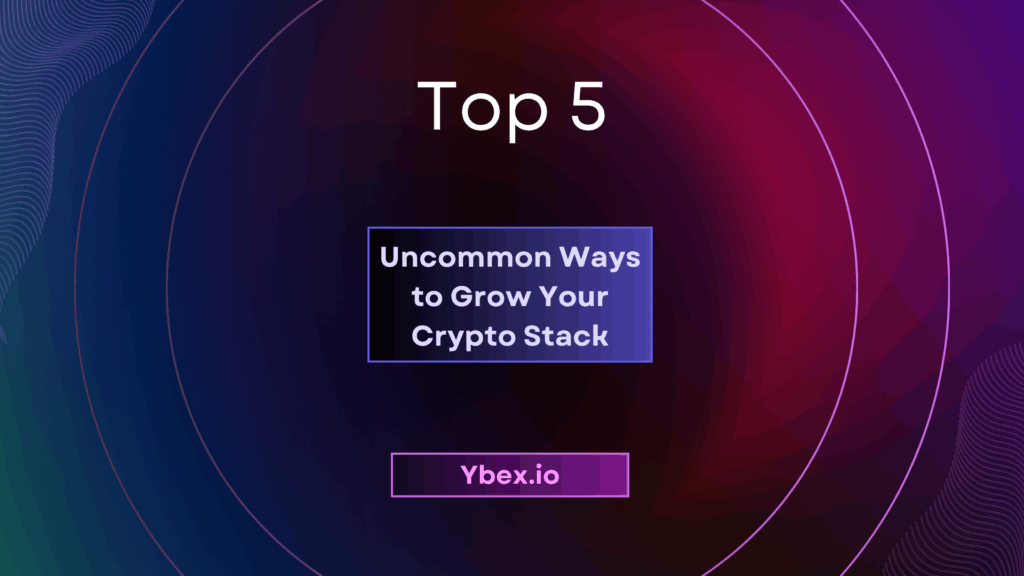Top 5 Uncommon Ways to Grow Your Crypto Stack
Cryptocurrency growth strategies often focus on the obvious: buying and holding, staking, or yield farming. However, the crypto ecosystem offers uncommon, under-the-radar opportunities to expand your holdings with creativity and strategic thinking. From niche DeFi protocols to emerging NFT-driven models, here are five unconventional methods to grow your crypto stack without relying solely on market rallies.
1. Participate in Private Sales and Pre-Sales (Exclusive Access)
What It Is: Private sales and pre-sales allow accredited investors or whitelisted users to buy tokens before public launches. These often offer discounted rates or exclusive rewards.
How to Access:
- Join whitelist platforms like SeedClub, CoinList, or Republic.
- Engage with project communities on Discord or Telegram for invites.
- Complete tasks (e.g., social media shares) to qualify for allocations.
Why It’s Uncommon:
Most retail investors miss out due to high barriers (e.g., minimum investments, accreditation requirements). However, platforms like Premined or KuCoin Spotlight cater to smaller investors, offering access to projects like Polygon’s ecosystem tokens or Layer-2 scaling solutions.
Risks:
- Fraudulent projects abound; vet teams, code audits, and whitepapers.
- Lock-up periods may restrict liquidity.
2. Earn Crypto Through Work or Freelancing
What It Is: Get paid in crypto for services like coding, content creation, or gig work.
How to Do It:
- Use platforms like Flexa (for in-store purchases) or BitWage (freelance payments).
- Monetize crypto knowledge via YouTube tutorials, blog writing, or consulting.
- Participate in bug bounty programs (e.g., Gitcoin or OpenZeppelin) for protocol security fixes.
Why It’s Uncommon:
While crypto-native platforms exist, many professionals stick to fiat payments. Adopting crypto for income diversifies your stack and reduces transaction fees.
Example: A developer earning ETH for auditing smart contracts or a content creator getting BTC for educational videos.
3. Leverage NFTs for Play-to-Earn (P2E) Games
What It Is: Earn crypto by playing blockchain-based games like Axie Infinity, The Sandbox, or newer contenders like Star Atlas.
How to Start:
- Invest in in-game assets (NFTs) that generate tokens.
- Complete quests, battle others, or stake assets to earn rewards.
Why It’s Uncommon:
While P2E gained traction in 2021, many users abandoned projects due to volatility or grind-heavy mechanics. However, next-gen games like Decentraland or Illuvium offer sustainable models with real-world asset utility.
Tip: Focus on games with strong communities and interoperable NFTs (e.g., Polygon’s ecosystem).
4. Use Prediction Markets for Crypto Earnings
What It Is: Bet on real-world events (elections, sports, crypto price movements) via platforms like Augur, Gnosis, or Polymarket.
How It Works:
- Stake crypto to predict outcomes. If correct, you earn tokens or fiat equivalents.
- Example: Predicting Bitcoin’s price at year-end for Gnosis Chain rewards.
Why It’s Uncommon:
Prediction markets are niche and require research. However, they offer diversification beyond traditional trading.
Risks:
- Regulatory scrutiny (e.g., SEC classifying predictions as securities).
- Volatile crypto prices impacting your stake.
5. Contribute to Open-Source Projects for Token Rewards
What It Is: Earn crypto by coding, testing, or writing documentation for blockchain projects.
How to Get Involved:
- Join platforms like Gitcoin or Gitcoin Grants, where projects fund open-source work with tokens.
- Fix bugs, improve code, or document protocols (e.g., Ethereum Improvement Proposals).
Why It’s Uncommon:
Most users don’t realize they can monetize technical skills directly in crypto. However, protocols like Cosmos or Polkadot reward contributors with their native tokens.
Example: A developer earns ATOM for improving Cosmos’s IBC (Inter-Blockchain Communication) protocol.
Bonus Tips for Maximizing Growth
- Diversify Your Methods: Combine strategies (e.g., P2E + yield farming).
- Prioritize Security: Use hardware wallets and audit smart contracts before participating.
- Stay Informed: Follow crypto news outlets like CoinDesk or Cointelegraph for emerging opportunities.
Conclusion
Growing your crypto stack doesn’t require waiting for bull markets. Uncommon strategies like private sales, P2E gaming, and open-source contributions offer creative pathways to accumulate assets. While risks exist, these methods reward proactive learners and risk-takers. Start small, research thoroughly, and let crypto’s decentralized ecosystem work for you.
FAQs
Q1: Are these strategies safe?
- A: Risks vary. Always vet projects, avoid scams, and diversify your portfolio.
Q2: How much can I earn monthly?
- A: Earnings depend on effort and market conditions. Niche P2E games or bug bounties can yield hundreds to thousands in crypto monthly.
Q3: Do I need technical skills?
- A: Some methods (e.g., freelancing, coding) require skills, but platforms like CoinList or Gitcoin offer roles for non-technical users (e.g., marketing, content).
Q4: Are prediction markets legal?
- A: Legal status varies by region. The SEC has scrutinized platforms like Augur, so research local regulations.
Q5: Can I combine these strategies?
- A: Absolutely! Diversification reduces risk and maximizes opportunities.

